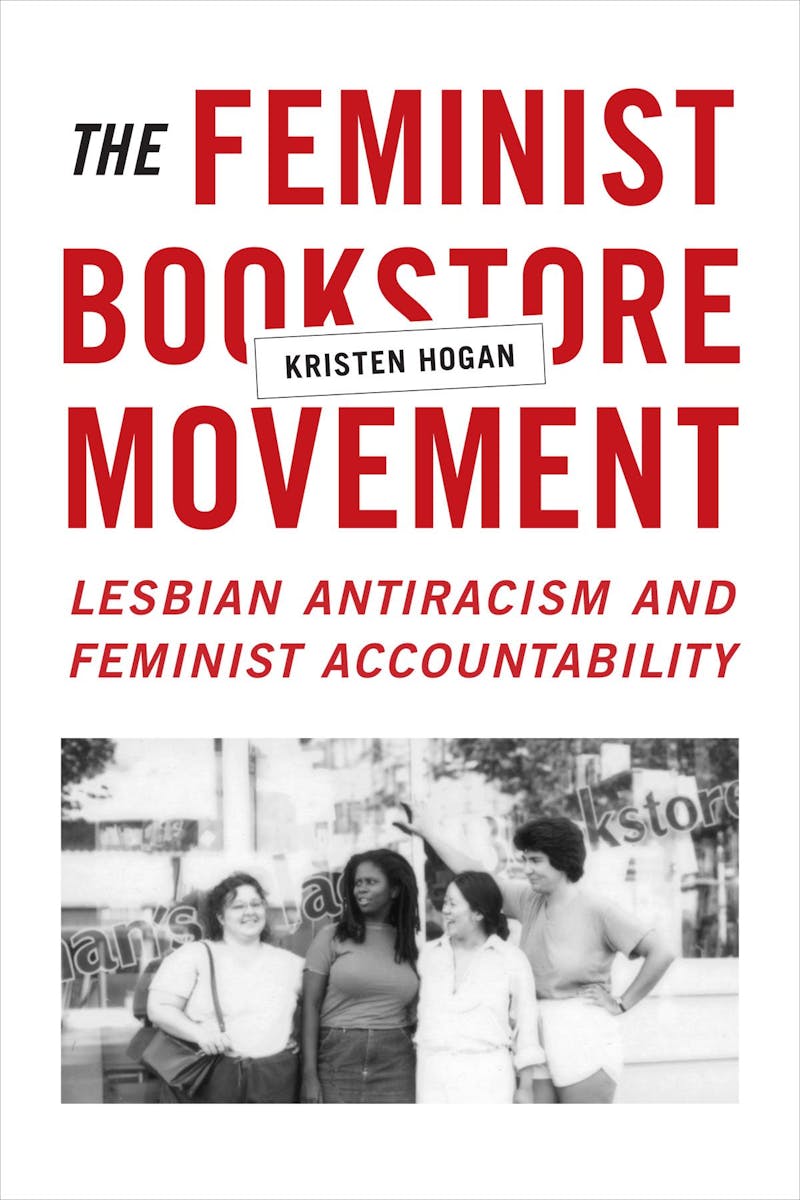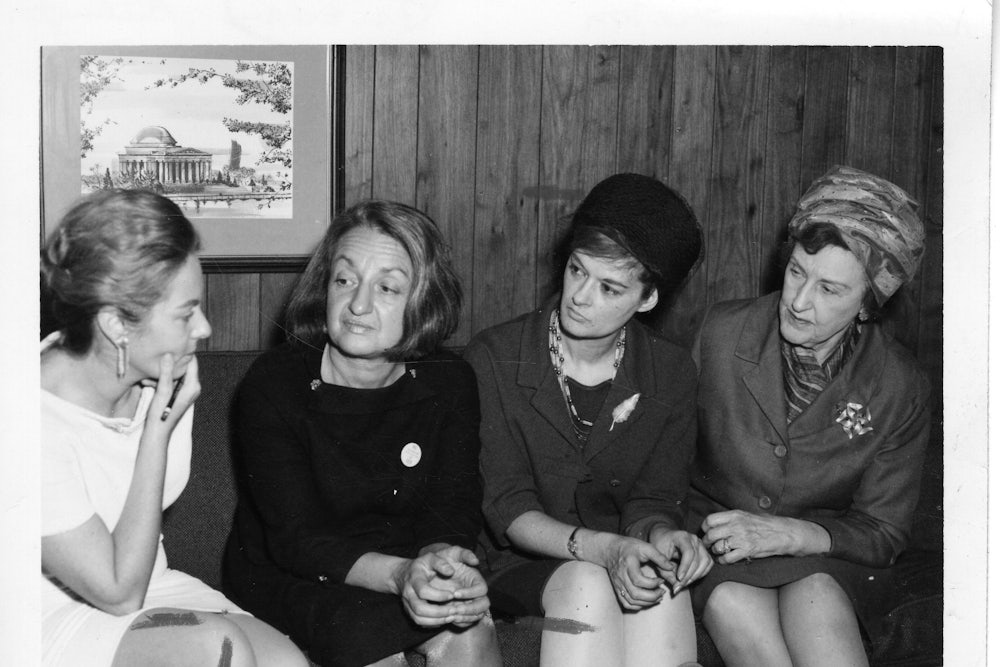“In high school The Second Sex was my Ann Landers,” activist and historian Rosalyn Baxandall once recalled. “I read and reread every wilted page for advice.” Barbara Omolade, active in feminism and Black nationalism, has described how, after reading Gerda Lerner’s Black Women in White America, “I was suddenly burning with questions about how women survived the transition from African woman to slave mother…my intimate and personal questions about how Black women in the past took care of their children linked the past with my own daily life.” And for activist and writer Meredith Tax, it was the first issue of the Boston-based journal No More Fun and Games: “As I read, I began to smile, for I recognized the voice: angry, raw, full of pain combined with a kind of bitter triumph at seeing the situation for what it was.”

In memoirs and oral histories, you see this experience again and again: women of the feminist movement of the late 1960s through the 1980s encountering the book or magazine that changed a life. (Shulamith Firestone’s The Dialectic of Sex was even advertised with the tagline “Chapter 6 Might Change Your Life!” The chapter in question tackled “Love” and how sex segregation had made emotion women’s work.) Whether through Firestone or Simone de Beauvoir, Audre Lorde or Adrienne Rich, activists recall how feminist consciousness entered their lives, how it became unthinkable after that to see their experiences and the wider world the same way again.
Books that spark
these kinds of transformation, however inevitable they might come to feel to
us, don’t just fall from the sky. They are inextricably bound up with the
friends who put them in our hands, with the groups that discussed them, with
the small publications that excerpted and publicized them. In her new book, The Feminist Bookstore Movement: Lesbian Antiracism and
Feminist Accountability, Kristen Hogan looks at an often ignored part of this story:
the international network of feminist bookstores that flourished from the early
1970s to the 1990s, with 130 stores at its peak. These stores applied collective
pressure to the publishing industry, and challenged business models that
claimed the best books would naturally find their audience. They helped sustain
the growing network of feminist periodicals and presses, like Kitchen Table: Women of Color Press, The Feminist Press, and Spinster’s Ink. They debated ways of
organizing books that would help readers find not just what they wanted but
also what they didn’t know they needed. And they played a crucial role in the
independent bookstore movement that opposed large chains in the 1990s and now
fights to live another day in the age of Amazon.
Hogan’s story is one of idealism—an idealism that, if it hasn’t been lost or diverted toward other forms of action, has been criticized in recent decades. The feminist movement of the 1970s particularly tends to get a bad rap nowadays for its lack of racial diversity, for focusing on the issues of most concern to affluent, college-educated white women. But Hogan gives us a more complicated narrative; she focuses on a broad base of women from different backgrounds working together as activists, rather than on a few commercially successful writers. It is a history from the bottom-up rather than a female-adjusted Great Man style of history.
If the second wave now looks less inclusive than it actually was, the feminist historian Stephanie Gilmore has argued, that may be because of our focus on only the most influential theories and concepts that emerged from it. If a certain influential text is not inclusive, then the movement must not have been. We see this in the persistence of the notion that Betty Friedan’s The Feminine Mystique single-handedly “launched” the movement. Yet when we look at actual grassroots activism, Gilmore argues, a different picture emerges, one where cross-racial coalitions faced challenges but also found ways to work together.
When we turn from a few prominent books to small presses and journals, bibliographies and syllabi, and the women who created them, we can’t tell one unified story. Some local movements were more successful in maintaining diverse collectives and communities than others. Certainly, feminist bookstores were central to spreading Audre Lorde’s work and to the influence of This Bridge Called My Back: Writings by Radical Women of Color, an anthology that contributor and black feminist scholar Barbara Smith described as “a document of and a catalyst for coalitions” between women of color who “were involved in autonomous organization at the same time that we [were] beginning to find each other.” Feminist booksellers—or bookwomen—also developed bibliographies of works by women of color and worked with academics searching for materials in emerging and interdisciplinary fields. They built connections to stores in Chile and India, and in the 1980s partnered with the solidarity movements organizing against U.S. imperialism in Central America.
“Nostalgia for an early feminist community is fueled by dreams of a time when the bookstores didn’t need to hold fundraisers,” Hogan notes. “That time never existed.” Inspired and shaped by the utopian atmosphere of the 1970s, feminist bookstores sought to establish countercultural spaces in which new ideas could circulate. They embodied a practical utopianism, where visions of transformation went hand-in-hand with daily struggles in building community in the most concrete ways. The Iowa City Women’s Press made Against the Grain: A Carpentry Manual for Women available free to all feminist bookstores. From the beginning, these small businesses, many of them collectives, struggled to function as “revolutionaries in a capitalist system.”
No one did more to this end than Carol Seajay, the editor and co-founder of the Feminist Bookstores Newsletter, who is the closest thing to a central figure in Hogan’s story. Having worked as an abortion counselor, inspired by the feminist periodicals proliferating at the time, Seajay travelled by motorcycle to the Bay area in the early 1970s, where she became a volunteer and collective member at the Oakland bookstore ICI: A Woman’s Place. Her newsletter allowed bookstores to network with each other, sharing information, book lists, and strategies for supporting feminist organizations and authors; for example, by ensuring writers received compensation for the sale of remaindered copies of their books.
Seajay also confronted the mainstream of the publishing industry, which she and activists memorably referred to as LICE (the Literary Industrial Corporate Establishment). She helped bookstores change the standard practice of returning books to the publishers if they didn’t sell fast enough, which sent publishers the message that there was “no audience” for feminist books. FBN and the network it created found ways to publicize important books and get out-of-print titles back in publication. The industry fought back, arguing that what bookwomen saw as solidarity was actually a violation of anti-trust laws.
All of this came to a head in the 1990s, when bookwomen became central in the movement to protect independent bookstores from the increasing power of the chains. Turning the American Bookseller’s Association into a vehicle for independent organizing, they sued five major publishers for offering preferable prices to chains and paying them to promote certain books, limiting the range of books available as well as putting independents at a disadvantage. Despite winning settlements with the five, only one, with Penguin, contained a monitoring provision—and Penguin was quickly found to be in violation. Beyond the economic threat, the chain’s philosophy denied the value of the intellectual and cultural work so important to the bookwomen. Chains argued that “good” books would naturally find their customers—that there was no need for the decisions bookwomen, like librarians and feminist scholars, were making in supporting, finding, and circulating new works.
This market logic would, of course, reach its peak with the triumph of Amazon. If the bookstore movement had had its way, however, our associations with the name might be different today. A different Amazon—a feminist store in Minnesota, opened in 1970—was the oldest in North America, as well as the model for Madwimmin, the bookstore in Alison Bechdel’s popular comic Dykes to Watch Out For. In 1999 the store sued the online giant for trademark infringement, claiming that confusion had led their customers to the online store and led vendors to offer and then pull discounts. Amazon.com lawyers grilled the bookwomen about their sexuality in court. (Amazon.com lawyer Paul Weller argued that “it’s important for the jury to know whether people who work in the bookstore have a particular sexual orientation.”) The costs of the suit forced the store into a largely unfavorable settlement. In 2008 new owners were forced to use a different name, and the store closed in 2012.
A third of feminist bookstores didn’t survive the 1990s, and in 2000 Seajay ended Feminist Bookstore News, the publication that did so much to help the network solidify into a movement. Recent articles have put the current number of self-identified feminist bookstores at about 14. Hogan points to another downside of this fight: In focusing on survival, bookstores, like many other feminist institutions, found themselves professionalizing and turning away from antiracist and political commitments and utopian spirit.
In light of revelations about Amazon.com’s atrocious labor practices, I was especially struck by the bookwomen’s emphasis on the importance of working somewhere they didn’t have to set any part of themselves aside. These were women like Pell, who came to San Francisco in search of a lesbian antiracist community. She worked at a feminist credit union and became part of the Old Wives’ Tale collective in 1980. The store “opened doors for women and opened their minds with all the dialogue, in talking about the books, discussing the books,” she would remember. “Whether racism or health issues, it was something that was going on that wasn’t going on anywhere else.” And they were women like Hogan herself, who weaves her recollections about working at two feminist bookstores into her book.
The creation of such communities is sometimes described today as prefiguration, as the attempt to create small places where we might live as though we were free from oppression. Activists often criticize these projects as a distraction from the real work of organizing. To some extent this is true: Women’s bookstores alone could not fight the massive backlash against feminism of the 1980s from which we have not fully recovered.
And yet their loss remains a powerful one. The same economic forces which make alternative spaces and cultures more difficult to sustain also make it more difficult for us to find the time and energy in our lives to fight for justice. The same forces which devalue the work of bookwomen attack the value of teachers, librarians, and of the humanities themselves, offering technocratic and corporate solutions to our most human problems. Not coincidentally, they are the same forces that encourage click-bait driven debates about who or what counts as feminist in place of real accounts of feminist ideas and organizing. Hogan’s story should make us think about how we can build the communities that will give us the next books that will change our lives.
